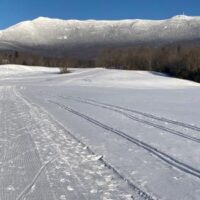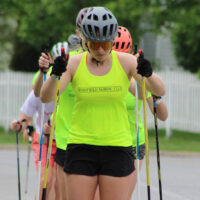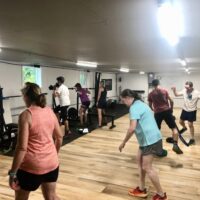Nordic ski training requires a lot of preparation. In all sorts of heat or cold, we skiers can be found outside putting in kilometers on skis, bikes, and foot. While MNC programs don’t meet during thunderstorms or below-race-legal temps (-4F), we’ll otherwise be going forward with our training.
There are a few standard pieces to bring to every session and have either on you at all times, or in your car/bag.

Water/hydration (and carrying capacity)
Hydration is huge! This applies to the colder months, not just the sweaty summer. While there will often be a large water jug for refilling, it’s best to always plan to have your own supply handy. We are big fans of “waterbelts” in most cases, which can be found at Skirack or other nordic sources. These are insulated and keep liquids from freezing in the cold, as well as staying out of the way of the poling motion. Most all waterbelts, whether ski-specific or not, have zippered pouches for snacks and more. For running, our team has become more and more fond of “hydration vests” which hold lots of liquid without causing bouncing or chafing.
Snacks/fuel
For workouts over an hour, having a snack during exercise can be very beneficial. We like quick, fast-digesting sugars like fruit snacks during training, but when it comes to post-workout refuelling it’s best to have something more substantial with carbs and protein. Granola bars are easy to keep on-hand, as is trail mix or crackers. For workouts longer than an hour, we also try to incorporate sports drink mix into our water, such as Skratch Labs powder. This provides carbs and sodium beyond what water can provide alone. Try to keep gummies in your water belt during training, and have a bigger snack ready in your backpack or car for the 15 minutes after practice ends.
Bright clothing for visibility
A lot of our training takes place on open roads that we share with cars and bikers and other athletes. For safety, it’s best to have bright clothing to be seen. MNC summer participants all receive a hi-viz T-shirt, but it’s worth picking up others and keeping color in mind when shopping. On trail runs and hikes we don’t ask for bright clothes, but when there aren’t bright colors at road sessions we often ask athletes to wear a safety vest (we travel with a bag of them).

Dry clothes for after training
One of the best things you can do for your recovery and health (and your own comfort!) is to bring a dry shirt for after training. It doesn’t matter what type of weather…cold, warm, dry, raining…taking off a sweaty piece of clothing and changing into a fresh shirt is something all top athletes do without question. Once you get used to it, you’ll always be bummed to forget an “after-shirt” to wear. In the winter, an “after-hat” (wool or comfy hat that you didn’t just ski in) can be just as nice and helpful for preventing sickness and cold.
Rain gear/Sun gear
While this doesn’t happen every practice, we’re not training in Colorado here and rain is a part of training for us. A light raincoat can be the perfect addition to your training backpack or back seat of the car just in case. In the opposite weather, protection from the sun can be very important. We keep sunscreen in the MNC first aid kit, yet it’s always good to have your own/favorite brand.
Pole business
Nothing is worse than breaking a rollerski pole tip at practice. While MNC carries around some spares, we can often run out quickly. We have the ability to change tips at practice, but when athletes have their own on-hand it makes life much easier. Just toss this into your waterbelt and forget about it…until you really need it! When we do ski bounding we’re looking to use poles that are shorter than classic length, about a length to put your elbows at a right angle. We have a bag of short poles we try to bring to any bounding practice in case skiers forget their bounding poles.
Watch/phone
For those tracking and logging their training, a watch is obviously a huge help. When we do intervals or structured workouts, watches also help keep skiers on task and on the same page. Phones can be useful for being in touch with parents, but best to bring a plastic baggie to protect from the rain!



